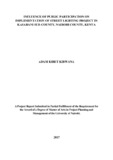| dc.description.abstract | Persons with disabilities (PWDs) have, and still do, face a myriad of challenges especially in their pursuit of basic social services here in Kenya and in the world at large. Students with disabilities especially in institutions of higher learning have always been on the receiving end. They have faced immeasurable portions of stigma, marginalization, segregation as well as oppression in schools due to their condition. Even in the wake of rapid democratization, global clamour for the respect of Human Rights and call for total inclusivity; schools, colleges as well as institutions of higher learning still remain largely non-inclusive. The purpose of this study, therefore, was to investigate the institutional factors influencing inclusion of learners with disabilities in the University of Nairobi, Kenya. The study was guided by four objectives. These were to determine the influence of physical facilities available on inclusion of learners with disabilities in the University of Nairobi; to assess the influence of the level of sensitization of staff members on inclusion of learners with disabilities in the University of Nairobi; to determine the influence of teaching/learning resources available on inclusion of learners with disabilities in the University of Nairobi; and to establish the influence of attitudes of non-disabled learners on inclusion of learners with disabilities in the University of Nairobi. The study adopted a descriptive case study design which is a research design used to study social systems like a school or a university. The sample of the study comprised of 96 respondents. Of these, 27 were university administrators in various hierarchical positions while 69 were students with disabilities. Two types of research instruments were used to collect data. These were questionnaire and interview schedule. The study employed descriptive statistics to analyze data. The data were analyzed using Statistical Package for Social Sciences (SPSS) where presentation was in form of tables, pie-charts and graphs. Findings showed that with regard to physical facilities available on inclusion of learners with disabilities, the university had made an effort to provide such facilities but they were not adequate. Adapted toilets and bathrooms needed to be installed. Speech lifts were also largely missing. Findings also revealed that staff members had not been trained adequately on how to handle learners with disabilities. The study showed that teaching/learning resources also influenced inclusion of learners with disabilities. These resources were not adequate. Finally, the findings revealed that the attitude of the non-disabled learners was generally good. A majority of the students with disabilities admitted that they felt accepted and respected. The study made the following recommendations: a) that the government should formulate clear policies on how best to promote inclusion in institutions of learning; b) that universities should work hand in hand with the government to provide both physical facilities and teaching/learning materials to learners with disabilities; c) that all university staff members be trained thoroughly on how to handle students with disabilities. The study suggested that more research be conducted to include more types of disabilities. | en_US |



